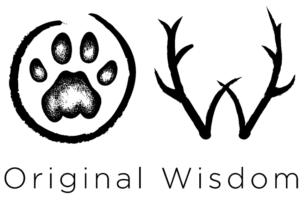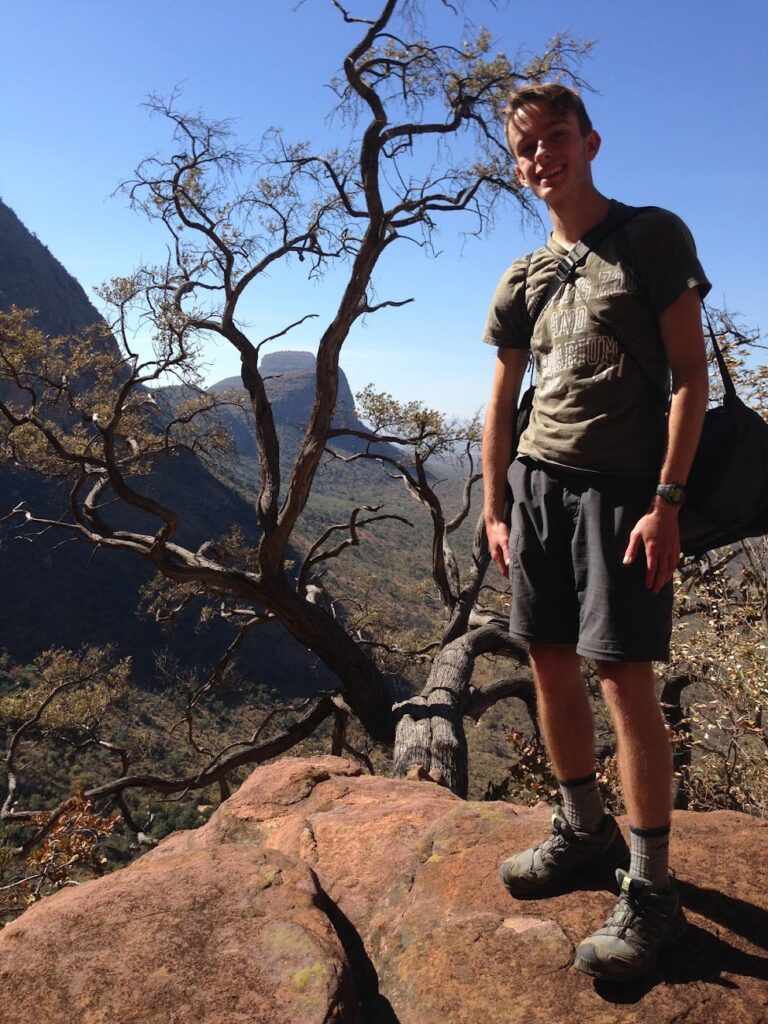A long way from New Hampshire – Our first day at Djuma (South Africa)
The following blog post is created by a Hopkinton/Bow High School student from New Hampshire, who is on program with Original Wisdom, partnering with Nature Guide Training, on a 3-week South African Ecology & Culture program at Djuma Game reserve in the Sabi Sands region of the Greater Kruger Area (July 2015). In addition to exposure to ecology and culture, we have sponsored a local South African student on scholarship for the entire program (see Blog 3# Interview with Mhlavasi) and will attend 2 days at Mhlavasi’s school, Acorns to Oaks, where our students interact with the local students and help to teach them some basic skills in spatial thinking and use of Geographic Information Systems (GIS) to create online maps and stories with a spatial component. Our overall goals include facilitating connections with self, others, and the natural world.
Michelle Neal
July 2nd, 2015
Day 1

Upon arrival to the Djuma Research Camp in the Greater Kruger Area of South Africa, our group of 11 Hopkinton and Bow High School students and 6 adults from New Hampshire, USA, set our luggage in our assigned rooms with haste. We grabbed cameras, binoculars, and jackets and immediately climbed into the two safari vehicles waiting: a Toyota Hilux and a Mahindra, seating 12 bodies each, including a tracker seat mounted upon the front of the vehicle, on the “hood” as we call it in the USA, or on the “bonnet” as they call it here in South Africa – the tracker seat is also known jokingly as the “bait seat” because of its usual close proximity to dangerous game. Lee Gutteridge and Diana Griffioen took the guiding positions in the drivers’ seats, and Kersey Lawrence and Acima Cherian claimed the trackers’ seats. Minutes after arriving at this unique facility, our first safari was underway on the sandy roads of Djuma.

The midafternoon sun shone powerfully upon South Africa’s breathtaking landscape. Kersey pointed to the sky and Lee immediately confirmed her observation of an African fish eagle, with a tilapia (a kind of fish) in its talons, soaring majestically across the sky. Silence swept over the group, with the exception of our cameras’ snapping with each picture.
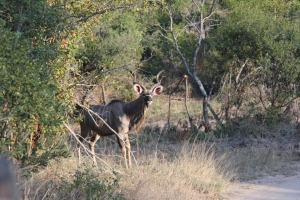

We’d barely travelled a mile before we came across a gathering of zebras AND kudu! It was an incredible sight to observe the two species living in harmony, a grazer feeding on grasses and a browser feeding from trees and shrubs; both species keeping watch against predators. Lee spoke with great enthusiasm of the kudus’ seven to eleven stripes on their torso, the sexual dimorphism between the larger males with huge spiraling horns and the smaller females without horns. He also described the kudus’ tendency to feed into the wind to prevent being poisoned by tannins in acacia trees that are reacting to herbivory – the trees release a chemical that others of their species can detect downwind, this chemical message causes the tree to increase the amount of tannins in their leaves and makes them unpalatable to the kudu; ingesting too much tannin will cause the kudu to sicken and maybe even death! We also found out that zebras are, in fact, black with white stripes! As we listened to the endless fascinating details of what was happening around us, butterflies excitedly filled my stomach and fluttered with anticipation over what I began to understand about what we should expect to experience in the next few weeks.
From here we continued on toward a particularly interesting sight: a clan of hyenas resting at their den! The den was called a Mpisi Khaya, where Mpisi means spotted hyena, and khaya means home – this home was dug into the side of an enormous termite mound. Spotted hyenas have a matriarchal dominant social structure, where males are the lowest in social status of all the clan, subordinate even to the young female pups; males are seldom seen (and difficult to identify since the genitalia of males and females is identical; we used behavior to determine that there were no males present at that moment at the den. There were two adult females basking in the sun not two meters from us, babysitting their months-old cubs that skittishly hopped around; one cub layed down to nurse from what we could then assume was its mother. Although we could not see them, we were told by a guide from the National Geographic show Wildearth that he had seen a couple of newborns cubs earlier that evening, but they now rested deep within the comfort of their den. We parked at the mpisi khaya, observing the pecking order between clan members behavior and posing our questions to Lee and Kersey until the sun touched the horizon, coloring everything in red and gold. Our first South African sunset presented itself brilliantly. Cameras snapped away, as all of us digitally recorded the beauty of this memory.

It was about 6:00 P.M. by the time full darkness descended upon us. Lee handed Kersey a spotlight and explained that she would only be shining it on nocturnal animals, or ones that are active at night, because shining a light in the eyes of diurnal animals (ones that are active during the day) will temporarily destroy their night vision and decrease their ability to avoid predators. As we drove, our bodies bouncing about over one bump to the next, we kept our eyes wide and our ears open. As we sat on a dam wall at a waterhole, shining the light over its surface, Kersey pointed to the far side and said she heard something. We all stopped to listen and, sure enough, we detected some noise coming from within the thickets. Lee said it could be a buffalo, or maybe a hippo, judging from the sounds, and we headed slowly towards the sound.
To my surprise, we quickly abandoned the sand road, following the sound carefully through the bush with the spotlight sweeping from side-to-side. Soon, behind some bushes and trees stood our first Big Five sighting: three white rhinos! Big Five, historically representing the hardest animals to hunt on foot: lion, leopard, elephant, Cape buffalo, and rhinoceros. We did not want to blind the rhino, so Kersey shined the spotlight on their large grey rumps, and we didn’t want to go too close to them at night and scare them, so we watched from a distance and listened to them step from grass clump to grass clump, chomping on tender grasses. Visibility was minimal through the vegetation, but we managed to capture their fierce horns curling from their snouts. Lee explained that we would have better sightings during the day and he didn’t want to disturb them too much at night, especially with them being currently persecuted to an endangered status by poachers seeking their horns to sell on the black market. The rhinos grazed quietly, paying no attention to the excited (and obvious) humans. Lee turned the vehicle around and followed the same route out of the bush that he had driven in on, to minimize damage to the low growing shrubs and to the compaction of soil, and we were soon back on the sandy road.
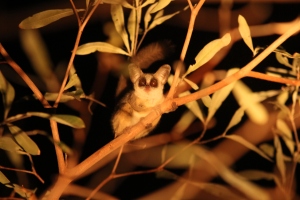
It was nearly 7:00 P.M., which meant dinner. Lee drove us back to our new home, but not without stopping to observe an occasional bush baby (Africa’s smallest primate) leaping through the trees or a scrub hare bounding across the ground. We also heard some elephants breaking branches in the distance

The first night’s dinner consisted of boerewors (a traditional South African meat where the name is derived from boer = farmer, and wors = sausage) and steak, pap (corn meal), roasted butternut squash and a veggie medley of carrot and green beans, roasted eggplant with cucumber-yogurt sauce, green salad, and hot chocolate, coffee, tea, or juice. What a meal! The group expressed utmost compliments to our cook, Thandekele, and her assistant Illusha, as we yawned deeply, bellies full and smiles wide.
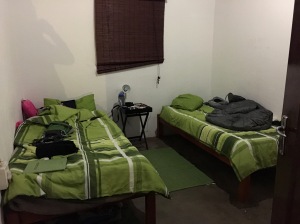
Not long after, I found myself in bed. One of my roommates, Naina, lay on the top bunk of the bunk bed beside my single bed, and Mhlavasi – our sponsored guest from an African school, Acorns to Oaks, in a village not too far from us – rested on the bottom bunk (See Blog 3, coming soon, by Zach Drotos, for more on Mhlavasi). We were too tired to converse much after our long days of travel followed by an exciting first game drive at camp. My eyelids drooped and my mind wandered. “What a magical beginning to this wild adventure,” I thought to myself. I had no idea that we had merely skimmed the surface of what was in store.
Edited by Kersey Lawrence
